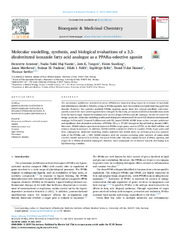Molecular modelling, synthesis, and biological evaluations of a 3,5-disubstituted isoxazole fatty acid analogue as a PPARα-selective agonist
Permanent lenke
https://hdl.handle.net/10037/16078Dato
2019-07-19Type
Journal articleTidsskriftartikkel
Peer reviewed
Forfatter
Arnesen, Henriette; Haj-Yasein, Nadia N.; Tungen, Jørn E.; Soedling, Helen; Matthews, Jason; Paulsen, Steinar M.; Nebb, Hilde I.; Sylte, Ingebrigt; Hansen, Trond Vidar; Sæther, ThomasSammendrag
The peroxisome proliferator activated receptors (PPARs) are important drug targets in treatment of metabolic and inflammatory disorders. Fibrates, acting as PPARα agonists, have been widely used lipid-lowering agents for decades. However, the currently available PPARα targeting agents show low subtype-specificity and consequently a search for more potent agonists have emerged. In this study, previously isolated oxohexadecenoic acids from the marine algae Chaetoceros karianus were used to design a PPARα-specific analogue. Herein we report the design, synthesis, molecular modelling studies and biological evaluations of the novel 3,5-disubstituted isoxazole analogue 6-(5-heptyl-1,2-oxazol-3-yl)hexanoic acid (1), named ADAM. ADAM shows a clear receptor preference and significant dose-dependent activation of PPARα (EC50 = 47 µM) through its ligand-binding domain (LBD). Moreover, ADAM induces expression of important PPARα target genes, such as CPT1A, in the Huh7 cell line and primary mouse hepatocytes. In addition, ADAM exhibits a moderate ability to regulate PPARγ target genes and drive adipogenesis. Molecular modelling studies indicated that ADAM docks its carboxyl group into opposite ends of the PPARα and -γ LBD. ADAM interacts with the receptor-activating polar network of amino acids (Tyr501, His447 and Ser317) in PPARα, but not in PPARγ LBD. This may explain the lack of PPARγ agonism, and argues for a PPARα-dependent adipogenic function. Such compounds are of interest towards developing new lipid-lowering remedies.


 English
English norsk
norsk